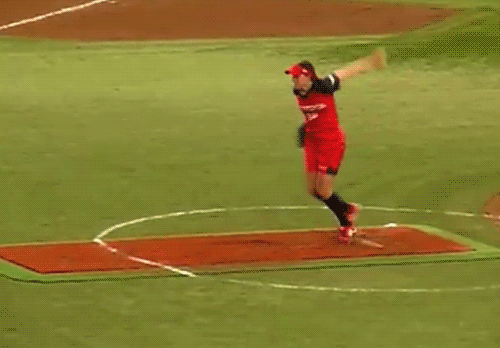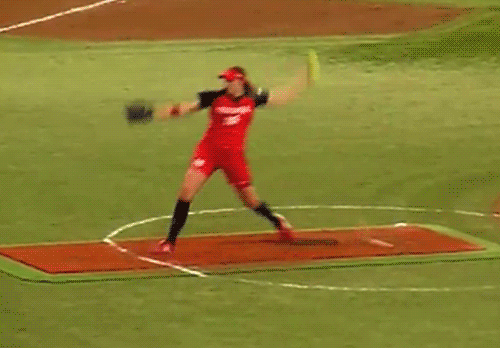An Extremely Common Drive-Through Problem
I know I’ve been talking about drive-throughs a lot lately, but I’m finding that the drive-through is the area where MOST windmill pitchers—even otherwise very accomplished pitchers—are almost universally lacking. Not only will a weak drive through rob you of speed, but it can also cause a chain reaction of countless other mechanical problems. There is a particular concept related to the drive-through that I think a lot of pitchers struggle with, and that’s what we’re going to discuss today.
Is your leg driving through by its own power?
In the past, we’ve discussed the differences between driving through and dragging through, and how a “drag” as opposed to a drive is a common result of a side-turned “anchor foot.” However, getting your foot in the right position is only half the battle. Many pitchers do not REALLY drive through even without the “anchor foot” problem.
When you’re pitching at full speed, the drive-through should be quite smooth. But if we watch a pitch in slow motion and break it down, we see that the drive-through can be divided into two phases: pre-landing and post-landing. The leg behaves differently in each phase. Let’s take a look at Monica Abbott for an example:
Pre-landing

Post-landing

During the pre-landing phase, the drive leg is basically riding on the momentum of the initial push. You should push so hard that you are able to propel yourself farther than the length of your natural stride, and as a result your drive leg will briefly trail for some distance before your stride foot lands. Monica is a perfect example of this, and you can even see a wonderful trail of black rubber in the turf to illustrate just how far her drive leg trails before she lands (you need to be very strong to do this without your posture breaking down, but that’s another story). During this phase, her toes only are grazing the ground and her knee remains pointed forward. This setup will help you make it through phase 2 correctly.
So in short, during phase 1, your drive leg, after pushing really hard, is trailing behind your body. MOMENTARILY.
A LOT of people have trouble with the post-landing phase, because during that time your drive leg is supposed to take over and finish driving through under its own power. Notice that although Monica’s drive leg trails at the beginning, the moment her stride foot touches down (actually, to be exact, right as her stride foot is about to touch down), her drive leg knee begins powering toward her catcher until it is right up next to the other leg. Many many pitchers do not do this.
What happens instead?
Usually, one of two things:
- The drive leg pretty much stops moving altogether after the foot lands, or just weakly trails a bit more after the pitch is delivered. Usually this makes the pitcher lean forward and/or lunge because the feet wind up uncomfortably far apart. The posture breaks down speed is lost.
- The pitcher will subconsciously realize her drive leg isn’t moving anymore and try to pull it through with her hip while the leg itself continues trailing behind. However, the hip really cannot pull the drive leg all the way through. Attempting to drive through this way leads to an incomplete drive-through usually in a squiggly or non-forward direction, loss of balance, or both. It also almost always leads to premature closing of the hips which affects accuracy. Notice how when the ball leaves Monica’s hand, you can still see the whole logo on the front of her shirt (i.e., she has not slammed her body around to face the catcher), and her drive leg is underneath her pitching arm, not lagging behind.
Study the animations of Monica until you really understand what is going on. Then practice that motion in a mirror without throwing the ball, over and over again, until you can feel your drive leg actively finishing under its own power.
In this video, it looks like her leap foot is almost straight forward. When they were teaching my daughter to pitch they told us it should be on a 45! Consequently she is more sideways when she plants and forces her drag foot to squiggle to side a bit instead of dragging straighter…your thoughts??
That’s a great question Mark. Abbott’s foot isn’t perfectly straight forward (it’s hard to tell from the video angle), but you’re right, she is more straight forward than how I would normally teach. I also advocate landing with the foot at a 45 degree angle to the power line. It helps younger pitchers maintain better front side resistance (Abbott is so strong that she can generate resistance with her front leg no matter what angle her foot is at).
However, the 45-degree plant should not cause the drive through to squiggle much. It CAN be a smooth curve, and it may squiggle a little when she turns to face forward to get into fielding position, but she should be turning forward after the ball leaves her hand, not before.
Hi Carly,
Great content as usual 🙂
I can see why the natural decelaration of the drive knee taking the leg past the stridge leg and in doing so bringing the drive side hip around to face the batter.
What I normally have my pitchers do is decelarate but keep the hip location as is with drive leg then planting down in a drop step fashion. The pitcher’s posture would remain leaning back until the drive leg lands.